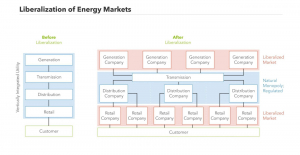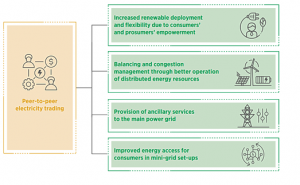Why P2P energy trading is key to digital transformation
While over 100 countries have committed to net zero carbon emissions by 2050, progress on the ground is slow. With leading nations still relying on fossil fuels for their energy production, there’s a long way to go. To tackle this issue, the integration of renewable energy resources into the existing grid is emerging as a viable option.
P2P energy trading is an energy consumption model that turns passive consumers into active producers. Peer-to-peer (P2P) technology is fueling the sharing economy. It’s disrupted traditional industries like banking and it’s set to do the same for energy.
With the digitisation of the energy network begun by the smart meter rollout, the options for consumers to save money and cut carbon emissions are multiplying.
The move from centralised energy production to a decentralised peer-to-peer model presents its challenges. First, there needs to be a greater adoption of small-scale renewable energy generation eg. But there are also technical and regulatory challenges to address.
In this article, we’ll explore how distributed ledger technologies like blockchain address these challenges and enable consumers to buy and sell their own energy. As such, we’ll show that P2P energy trading is the future of the digitally-enabled energy grid.
The current state of energy trading
Before 1996 the supply of energy in the European market was controlled by monopolies. They owned production, distribution, and trading of energy. These monopolies were able to set energy prices and restrict access to new entrants since they also owned the infrastructure.
In order to stimulate competition in the internal energy market, the European Union began liberalising electricity and gas markets in 1996. Instead of developing competing networks, liberalisation separates production and supply on the one hand and distribution on the other.
This meant that generation, transmission and distribution became “unbundled”.
Where a monopoly had to be maintained (typically distribution) regulations would control the activities of operators. This would then leave energy supply open to competition.
To enable fair access to the grid for producers and suppliers, distribution would have to be maintained by independent network operators:
- The first Electricity Directive in 1996 (Directive 96/22/EC) required suppliers to separate their accounts for production, transmission, distribution, and supply activities.
- In 2003, Directive 2003/54/EC went further, and required functional unbundling. This created vertically integrated companies (VICs) which separated the transmission and distribution from the production and supply activities. This meant that each function was ensured by a separate company. However, this did not prevent these companies from belonging to the same group of companies.
- The 2009 Electricity Directive recognised this limitation and introduced 3 new types of unbundling for network operators only: 1) In ownership unbundling, producers and suppliers cannot own network operating companies and vice versa. 2) Alternatively, network operators can choose not to operate the network themselves and appoint an independent system operator (ISO) instead. 3) Lastly, network operators can choose to remain within a VIC and become an independent transmission operator (ITO). However, strict rules prevent the parent company from intervening in the affairs of the network operator.

The Renewables Directive (Directive 2009/28/EU) introduced in 2009 requires network operators to ensure their grids are able to receive supplies from renewable energy production resources. They are also required to provide priority access to these resources.
What is P2P energy trading?
To meet net zero carbon emission targets, mass adoption of renewable energy resources is needed. Traditionally, consumers of energy are the passive recipients of supply from utilities. As the concept of democratisation of resources gains popularity, coupled with greater environmental awareness, there’s a growing distrust of utility companies.
The prosumer has a key role to play in the emerging energy trading economy. A prosumer consumes energy but also resells any surplus back to the grid, or to a neighbour. Peer-to-peer, or P2P energy trading is the natural vehicle for this new economy.
Prosumers access the main grid through microgrids. A microgrid is a small-scale power generation system. It generates renewable energy locally via devices such as solar panels or wind turbines, and connects to the main utility grid. It’s a two-way system that balances the load between local power generation and the main grid. Thus, prosumers can buy or sell power from or to the grid. Microgrids can also operate independently in what’s called an islanding mode, disconnected from the main grid.
A decentralised P2P energy trading grid has many benefits including cost savings for consumers, increased network resilience, and fewer grid losses. But as the grid grows larger, trades between independent agents become more complex. Thus, there’s a need for a stable and reliable solution for data exchange and load balancing on the network.
Blockchain technology is generating a lot of interest in that regard. A blockchain is an open distributed ledger that records transactions verifiably and permanently. Distributed ledgers themselves are databases which store information across multiple sites. They aren’t controlled by a central authority. Combined with smart contracts, a blockchain stores tamper-proof records of transactions.
Blockchain technology enables P2P transactions in a transparent and secure manner:
- It’s open and accessible to all
- It records transactions efficiently and is scalable
- The transactions, once recorded, cannot be altered
Basic set-up of a P2P energy trading platform
Setting up a P2P energy trading platform is not just about the technology. Market and regulatory factors contribute to a successful implementation.
Grid set-up. In order to create a viable P2P network it makes sense that there should be enough participants that wish to trade energy. There should also be a sufficient number of participants with power generation capacity. Participants should also decide whether to install a separate transmission line or whether to trade via the main grid. The P2P enabled grid, or microgrid, should be able to couple with the main grid as well as operate separately in islanding mode. Thus trading is possible with the participants on the microgrid exclusively, or surpluses can be traded with the main grid.
Hardware. At the physical level we need smart meters that monitor power production in real time, as well as smart grids (mini-,grids, microgrids, nanogrids). At the virtual layer, secure communication protocols enable communication between participants, encrypt transactions etc…
Software. Software provides a platform for P2P energy trading, supply and demand forecasting, and data analytics. Software also provides for the automated execution of trades. control of pricing mechanisms, and energy bidding mechanisms.
Regulations. Regulations govern the collection and use of data. They also outline roles and responsibilities of stakeholders, define market operation rules, and protect the rights of consumers. They provide for network access criteria and network access charges.
Benefits of P2P energy trading
We’ve just seen how P2P energy trading enables consumers to take control of their energy supply, contribute to reducing carbon emissions, and make a positive contribution to their community.
P2P energy trading supports mini-grids
Most P2P energy trading projects operate on isolated mini-grids, also called microgrids. Users on the mini-grid are often supplied with power through home solar panels which cannot store surplus electricity.
A P2P mini-grid enables homes connected to the grid to access surplus electricity. This improves access to local renewable power generation. It also makes the community resilient to power outages and may also improve access to the main grid.

P2P energy trading supports the main grid
A P2P microgrid balances local supply and demand in real-time. It reduces peak loads on the main grid. Thus it reduces the need to invest in capacity and infrastructure that meets peak demand. The operator of the main grid can further incentivise prosumers that help reduce grid congestion. Furthermore, the P2P microgrid can serve as a virtual power plant that coordinates distributed energy resources.
P2P energy trading facilitates Citizens Energy Communities
As part of its commitment to place the EU at the forefront of the clean energy transition, the European Commission released the Clean Energy for all Europeans Package (CEP) in 2016. The package consists of 8 laws affecting, among others, renewable energy, energy efficiency, and most notably electricity market design.
With the package, the EU aims to place the consumer at the centre of not just consumption but the generation of electricity. This will give European consumers a greater choice of electricity supply, access to reliable price comparisons, and the opportunity to produce and sell their own electricity.
Citizen Energy Communities (CECs) will have the power to generate, distribute, consume, store, or provide other electricity services such as electric vehicle charging to its members. CECs are based on voluntary participation and are controlled by members and shareholders. The CEP also makes provisions for Renewable Energy Communities (RECs) where all energy production assets are renewable.
The Clean Energy Package stipulates that the energy trading process should not be hindered by or influenced by the collection of network tariffs. Furthermore. CECs are empowered to apply whatever technology they need to facilitate the trading process. This leaves the door wide open to P2P energy trading platforms.
Final thoughts
Ever since 190 countries committed to reducing global carbon emissions at the Paris summit in 2015, the European Union and other governing bodies have been searching for ways to encourage mass adoption of renewable energy supplies. P2P energy trading empowers consumers with access to fair energy prices but also turns them into producers that serve their local communities. It comes at just the right time where environmental responsibility and the democratisation of resources is becoming centre stage.




Leave a Reply
Want to join the discussion?Feel free to contribute!